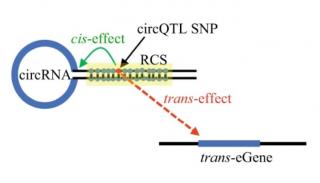Nov, 2022

Genetic risk variants and transcriptional expression changes in autism spectrum disorder (ASD) were widely investigated, but their causal relationship remains largely unknown. Circular RNAs (circRNAs) are abundant in brain and often serve as upstream regulators of mRNAs. By integrating RNA-sequencing with genotype data from autistic brains, we assessed expression quantitative trait loci of circRNAs (circQTLs) that cis-regulated expression of nearby circRNAs and trans-regulated expression of distant genes (trans-eGenes) simultaneously. We thus identified 3619 circQTLs that were also trans-eQTLs and constructed 19,804 circQTL-circRNA-trans-eGene regulatory axes. We conducted two different types of approaches, mediation and partial correlation tests (MPT), to determine the axes with mediation effects of circQTLs on trans-eGene expression through circRNA expression. We showed that the mediation effects of the circQTLs (trans-eQTLs) on circRNA expression were positively correlated with the magnitude of circRNA-trans-eGene correlation of expression profile. The positive correlation became more significant after adjustment for the circQTLs. Of the 19,804 axes, 8103 passed MPT. Meanwhile, we performed causal inference test (CIT) and identified 2070 circQTL-trans-eGene-ASD diagnosis propagation paths. We showed that the CIT-passing genes were significantly enriched for ASD risk genes, genes encoding postsynaptic density proteins, and other ASD-relevant genes, supporting the relevance of the CIT-passing genes to ASD pathophysiology. Integration of MPT- and CIT-passing axes further constructed 352 circQTL-circRNA-trans-eGene-ASD diagnosis propagation paths, wherein the circRNA-trans-eGene axes may act as causal mediators for the circQTL-ASD diagnosis associations. These analyses were also successfully applied to an independent dataset from schizophrenia brains. Collectively, this study provided the first framework for systematically investigating trans-genetic effects of circQTLs and inferring the corresponding causal relations in diseases. The identified circQTL-circRNA-trans-eGene regulatory interactions, particularly the internal modules that were previously implicated in the examined disorders, also provided a helpful dataset for further investigating causative biology and cryptic regulatory mechanisms underlying the neuropsychiatric diseases.